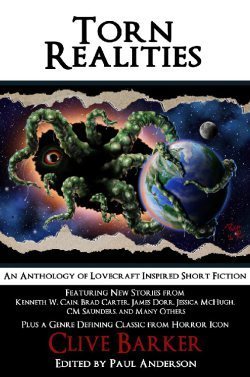Matt Moore's Blog, page 17
May 3, 2012
Community Season (Series?) Finale – How It Could Have Ended

[I wrote this post before watching tonight's episode, so the Greendale Seven's expulsion from Greendale kinda puts a crimp in this post. So, please just go with it and take it for the humour it's intended as.]
It’s possible Community may meet its demise at the end of this, its third, season. Over on the Page of Reviews, Adam Shaftoe writes up some predictions on what might happen with the rest of Season 3 and into Season 4.
For me, I think this is it. While horrible, fans of the show can take solace in knowing it never jumped the shark, staying true to its premise of providing humour both intelligent and guffaw-worthy. In a review of The Cabin in the Woods, I compared the movie to Community in that they both “examine the form while obeying the form.”
So if Community was going out, what could it do to go out on a level not seen before? How about evoke some old TV tropes—break the fourth wall or “it was all a dream.” (Granted, the third season has wrapped and the show’s fate is still in limbo, so all of this is hypothetical.) The question is: Who will prove to be the main character who speaks to the audience or is the dreamer responsible for Greendale?
Below are seven scenarios for our seven main characters.
Jeff Winger
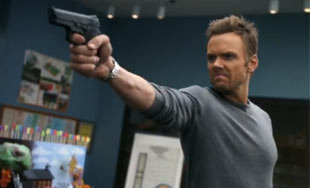
Can Jeff pull the trigger on leaving Greendale and return to life as a lawyer?
When Jeff’s former boss Ted (guest star Drew Carey) asks for Jeff’s input on a case Jeff had worked on, Ted is so impressed he offers to let Jeff come back to work. While he has not completed his studies, Ted indicates he can make arrangements and Jeff has “pretended” long enough to have learned his lesson.
Jeff is elated at the possibility of regaining his former life. Returning to Greendale, he sits down with the study group. But immediately we sense the dynamics are different—it’s just a study group. The (mis)adventures of the last three years have all been imaginings by Jeff to compensate for what he had lost.
He says good-bye to them individually and we learn their true realities. He’d hooked up with Britta a few times, but in reality she is not his exact foil, merely a disinterested and lost young woman. Troy is a resentful jock. Annie still pursues Troy but has not conquered her addiction. Shirley is a single mom who uses religion to make excuses rather than a source of strength. Pierce, though, is exactly the same as in Jeff’s imagination. This leaves Abed, who is a cool but hyper-intelligent genius attending Greendale rather than Yale so he can care for his sick mother. With his pick of women, Abed is a source of envy for Jeff.
In parting, Abed asks Jeff if he had a lot of friends in his life as a lawyer. Jeff is forced to admit that he didn’t, which troubles Jeff. Abed observes that Jeff has always seemed the most outcast person at Greendale; someone who doesn’t fit in anywhere and without the study group, Jeff would have been completely alone. As Abed walks away, Jeff pursues him, asking if Abed likes “Inspector Spacetime,” which Abed does.
Over the credits, the study group is outside a paintball range, suiting up. Pierce opines it’s stupid, but Jeff asks the group to trust him. It’s this, he says, or Advanced Dungeons & Dragons. The proprietor (guest star Josh Holloway) asks if the group is ready.
Shirley Bennett
[image error]
We know from “Mixology Certification” that Shirley has a drinking problem in the past. Does it stay in the past?
We open on Jeff’s cell phone ringing late at night. It’s Shirley and she has been arrested for DWI. Arriving at the police station, the group works together to help Shirley. Jeff acts as her attorney, Pierce offers bail money, Troy has heard other black students have been harassed by the arresting officer and will get names, Annie counsels her about addiction and Britta will drive her home. Abed opines that this all seems like a very special episode of some sitcom.
We learn Shirley has had a fight with Andre and turned to alcohol. While everyone is there for Shirley, Abed can’t stop comparing the situation to a sitcom involving substance abuse—the series finale of M*A*S*H, Tom Hank’s role on Family Ties. Shirley finally sits down with Abed and tells him this is not some TV show but real life. With that, Shirley realizes she has used Greendale as an excuse to not deal with the problems in her life. She walks away and we cut to her walking into AA where she admits she’s an alcoholic and has been drinking the last three years and is unsure what is real and what has been a drunken fantasy.
Over the credits, Andre and Shirley sit at a picnic table on Greendale campus. Members of the study group wander past, not recognizing Shirley even though she smiles when she seems them. Andre asks if she’s ready to give Community College a try. She is, Shirley tells him. It’s time.
Abed Nadir

We better get back to the darkest timeline before the series ends!
Abed enters the study room and immediately turns to face the camera like he can see it. While the study group talks about plans for the summer vacation, Abed opines about tricks that televisions shows use in the final episode of the series, including characters breaking the fourth wall. Abed, though refuses to look at the camera since to do so would mean this is indeed the last episode. While the other character pretend to speak to the camera—not quite looking directly into it, much to Abed’s consternation—Abed wonders what happens to a television show’s characters when the show is canceled. Do they die? Forced to repeat their actions endlessly?
No one in the study group is interested. Instead, they begin discussing longer-term plans: Jeff and Annie pursue a relationship; Shirley is going to finally start her own business and won’t be back next semester; Britta is moving to the West Coast to join the Peace Corp again; Pierce is offered a position with a competitor of Hawthorne Industries; Troy is offered a football scholarship at City College. Abed sees this for what it is—permanent closure for the characters. Abed refuses to think beyond ten minutes from when he is—and that would be with ten minutes left in the show.
As the plot winds down, Abed knows Act Three is ending. Realizing he has no future, he runs into the Dreamatorium and we fade to black.
The end credits are Abed in the Dreamatorium re-enacting his first scene from the first episode when he meets Jeff. As the credits come to the very end, he finally address the the camera, desperate, saying “No, please, Dan, don’t leave me in limbo. Don’t—!”
Britta Perry
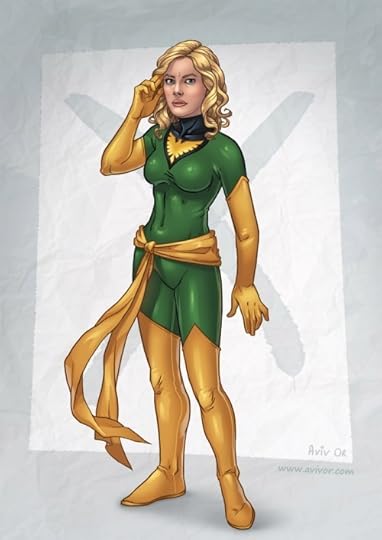
Britta as Rogue has nothing to do with my review, but it’s kinda cool.
We begin with Annie announcing she is transferring to Yale at the beginning of next semester. The study group is excited for Annie, who tells them it is time she grew up and took control of her life. Everyone says something nice, but they all talk over Britta as if she isn’t there. But Annie gives Britta a pleasant, understanding smile and Britta takes that to mean everything is OK.
Pulling an all-nighter to prepare for the biology final, rather than study the group shares their favourite Annie memories. The trouble is, in these memories either Britta is absent or Annie fills the role of Britta. Britta tries to point this out, but no one is listening. Finally, Britta excuses herself to go the the washroom and Annie follows.
Finding Britta about to light a joint, Annie tells Britta that Britta has been the idealized projection of Annie that Annie has used to built confidence. In a Fight Club like montage, Britta sees scenes from past episodes, but with Annie. Britta resists this revelation and turns the table on Annie, pointing out scenes were it would be impossible for them to be the same person. What’s more, it’s more likely that Annie is Britta’s projection of a younger, less-jaded self. And, she adds that Abed would call this some kind of forced, jumping-the-shark series finale gimmick.
Annie smiles warmly, turns and leaves an empty washroom, heads down the hall and then as Britta turns into the study room. Abed says he’ll have to come visit Britta at Yale to see the places where they filmed scenes from Indiana Jones and the Kingdom of the Crystal Skull.
In the closing credits, Troy and Abed help Britta move out of the apartment. Britta says she’ll always treasure the time she played Inspector Spacetime in the Dreamatorium with Abed.
Pierce Hawthorne
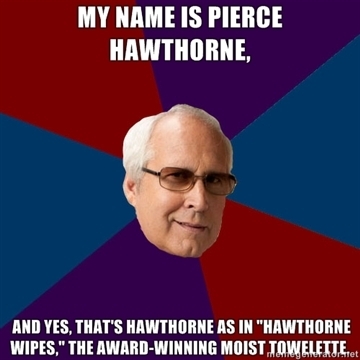
Pierce is a hard character to feel sympathy for. But what if he devolved so far we completely lost him?
After falsely accusing the study group of cheating in order to try to curry favor with Professor Kane, Pierce is threatened with expulsion from Greendale. Knowing he has crossed a line, Pierce begs forgiveness, confessing he is still addicted to the pain pills and has been for some time. Abed makes Chevy Chase references that Pierce objects to, but he flubs his line and says it again. No one notices.
Wanting the group to like him, Pierce invites them to a country club he belongs to. The Caddy Shack references are impossible for Abed to resist. As the study group decides whether or not they will accept Pierce back into the group, we see production mistakes like a boom mike in the frame or continuity errors. Abed comments on these and Pierce says “What do you expect?”
On the golf course, Abed continues to make Chevy Chase references, making Pierce flustered, unsure of what to say. He finally says “Cut! Why can’t you just stick to the script, Danny?” Danny Pudi remains in-character, but we hear a voice off camera yell “Cut!” and we snap back to the scene where Abed delivers a less funny, but obviously scripted line, that Pierce can reply to.
Impersonating Rodney Dangerfield, Abed wants Pierce to play out a scene. Pierce breaks character, becoming Chevy Chase and begins ranting about why no one can stick to the script. He storms off the set, leaving the rest of the cast in awkward confusion with the camera crew clearly visible. Fade to black.
There is no skit over the credits.
Annie Edison
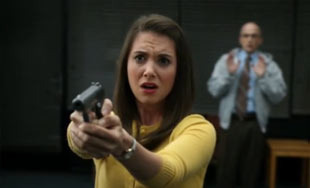
Annie’s got a gun! Which has nothing to do with the series finale focusing on her.
Freaking out about her biology final, Annie reaches into her bag and removes a small vial of pills. Before she can pop one in her mouth, Professor Kane stops her, wanting to know just what the hell she is doing. We cut to Annie and Kane in an institution and realize Annie is still addicted to pills and never went to Greendale.
Facing her addiction, we come across the people in the facility she has idealized as Greendale students. Jeff is her lawyer and her only hope of getting out of rehab with a clean criminal record. Britta is a bored case worker who alternates between liking Annie and having no interest in her. Shirley is an older patient hoping her faith can pull her through. Abed is a young, eccentric doctor who might be able to find the motivation Annie needs to get clean. Pierce is her harsh, distant father who wants her to get clean to avoid a scandal. Chang is a security guard smuggling pills into Annie. We finally meet Troy, who is the Troy from the show—positive, smiling and optimistic. He tells Annie about the great group of friends he has made at Greendale and that she needs to get clean so she can join him at community college. In this reality, Troy pursued Annie rather than Annie pursuing him. Annie nods and returns to Dr. Kane, who is the last of several administrators to come and go. She admits to flights of fancy, but has reached a point where it it time to get clean.
Over the credits, Annie is at Greendale with Troy with all the other characters, bickering over the menu at the cafeteria. We pull back to the building, the campus, the town, the world and finally to a snow globe that Annie, her eyes glazed over from the pills, is staring at.
Troy Barnes

Troy sporting his Riverside jacket. What if Troy went back to being a jock?
Begin looking up at the sky. Bright, blue, free of clouds. We hear voices, like a large crowd.
We jump to Troy in the study room, day dreaming. Abed wonders where he’s gone and Troy says nowhere. They return to studying Spanish and we realize we are back in Season One.
After the opening sequence, we’re back looking at the sky, faces crowded around. Cut to Troy going into anthology class with guest star Betty White. Abed grows concerned, but Troy says it’s nothing. We continue to jump between various scenes—the ceiling of an ambulance, being wheeled down a hallway staring at the ceiling, the ceiling of an operating room—and famous moments from season two and three of Community. We begin to realize Troy has had a horrible injury while playing football and his years at Greendale have been dreams. In the last scene, the doctors tell Troy he’s been in a coma for three years, but there is a risky procedure that could bring him out of it. Troy says no thanks, he’d prefer to stay in the coma.
Over the credits, Abed asks Troy if he could, would he stay at Greendale forever. “Definitely,” Troy replies. “All that’s out there is the real world.”








April 24, 2012
Great Quote on Horror from John Truby
In a review of 28 Days Later, American writer, director and screenwriting teacher John Truby said:
Good horror takes this reduction of characters and makes it positive. It asks: What is human? And can this human quality be maintained in a world where everyone is desperate and induced to be an animal, ie going beyond even immoral behavior to amoral behavior? In short, good horror creates a recognizable human world where people are morally tested in the extreme.
I couldn’t agree more!
But this is also what makes writing horror such a challenge. While Fantasy and Science Fiction can whisk you away to to the far future or distant kingdoms, I’ve always felt good horror needs to take place in a setting as close to the real world as possible. Readers need to be able to identify with the world and picture themselves in it. This intimacy is vital if you want to have any chance of scaring the reader. The reader needs to feel at risk with the main character as their proxy.








April 23, 2012
“The Cabin in the Woods” Review – Celebrating and Dissecting the Horror Formula
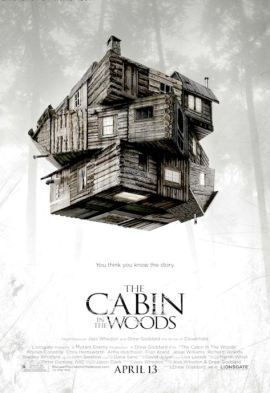
The poster for The Cabin in the Woods hints at its twisty story
As I’m about to write this review, I wonder: Is what I’m about to say really going to change your mind about seeing The Cabin in the Woods? Either you’ve been waiting for it for years or don’t care.
So, I will try to speak to those who plan to see it, but haven’t. To that end, this is a spoiler-free review… and man will that be tough!
To write a spoiler-free review would mean saying essentially nothing because there is a lot going on in this movie.
So here goes…
First of all, it is a horror movie in the generic sense. There is blood, violence and horrific deaths. But, like everything from Halloween to the latest slasher flick de jour, that also means there are scenes played for laughs. Let’s keep in mind this comes from Joss Whedon and Drew Goddard. Considering their credentials (Lost, Alias, Buffy, Angel, Cloverfield) they have done great work in horror that thrills, entertains and amuses us.
Second, despite rumours, there is not a twist ending. At least, not in the M. Night Shyamalan sense of a twist ending. From the trailers, you know there is an elevator and a control room. The “twist” people might be talking about is the reveal of what these things have to do with the cabin. But it is no more a twist than who the killers are in the original Friday the 13th or Psycho. It’s more of a reveal.
Third, this is a post-modern film. It knows it is a horror movie, knows what the audience has come to expect (and can predict) and plays with those assumptions.
That is to say, while it follows the usual horror tropes (because it is a 90-minute horror film about college kids partying at a cabin in the woods), it also examines those same tropes. While Scream used hip, meta sensibilities to hold a mirror up to the horror genre, The Cabin in the Woods takes a step back at what might be behind or beyond or through the horror clichés. Is it We-the-Audience? The suits-at-the-studio that get in the way of the creative-types and insist on the same old formula? Cthulhu?
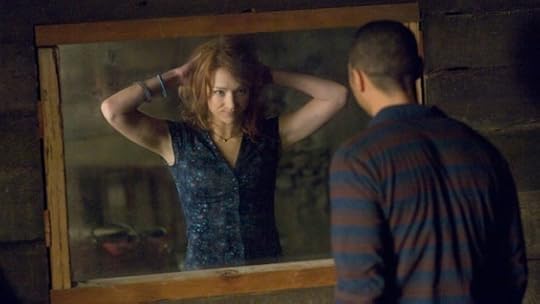
While Scream held up a mirror to the horror genre, The Cabin in the Woods looks behind, beyond and through them
(As an aside, if you’ve seen the trailer you know there is a one-way mirror gag. I wonder if this is a subtle way of hinting at The Cabin in the Woods’ self-awareness. One side reflects, one side sees through.)
To say any more on this point would enter spoiler territory, but I will say this: Pay attention to the opening credits. They are important and might give you a clue as to where the movie is going and what it’s really about. Oh, and there is not a post-credits bonus scene, but Nine Inch Nails’ “Last” does play over the credits, which sounds awesome on theatre speakers.
Another example of The Cabin in the Woods’ awareness of being a horror movie comes from two scenes that will have you reaching for the remote to freeze-frame (assuming you watch on Blu-Ray). No spoilers on what they are, but if you see it with a horror fan you will be talking about these two scenes after the movie to compare what you saw.
All-in-all, The Cabin in the Woods is a smart, funny and gory horror movie. Go see it in the theater. It has everything fans of horror movies could want. But, I will say it might disappoint hardcore horror fans. This is not Saw or Hostel. It isn’t looking to re-invent horror, but rather stick a finger in the eye of the same-ole “horror” movies with which true fans of the genre have become exhausted.
But, for fans of the genre who like to discuss and ponder rather than passively consume, it has several layers of disquieting questions it poses to the audience. Aside from Scream, The Cabin in the Woods evokes both Community and Behind the Mask: The Rise of Leslie Vernon in taking viewers on a trip that examines the form while obeying the form, and at no time taking the viewer out of the movie. In other words, this is not some boring art-house film. It kicks ass.
I’ll close by inviting you to consider the ending of the film and if you were satisfied with the choice the characters made. And, what shape do you think a sequel to The Cabin in the Woods would take? Scream understood the importance and clichés of horror movie sequels. Could we see a Return to the Cabin in the Woods? [Fair warning: I reserve the right to edit any comments to keep this spoiler free.]
If there is no sequel, I can only hope this film convinces some studio somewhere to give Joss Whedon a bucket of money so he can make that rumored Buffy remake himself.








Review: The Cabin in the Woods

The poster for The Cabin in the Woods hints at its twisty story
As I’m about to write this review, I wonder: Is what I’m about to say really going to change your mind about seeing The Cabin in the Woods? Either you’ve been waiting for it for years or don’t care.
So, I will try to speak to those who plan to see it, but haven’t. To that end, this is a spoiler-free review… and man will that be tough!
To write a spoiler-free review would mean saying essentially nothing because there is a lot going on in this movie.
So here goes…
First of all, it is a horror movie in the generic sense. There is blood, violence and horrific deaths. But, like everything from Halloween to the latest slasher flick de jour, that also means there are scenes played for laughs. Let’s keep in mind this comes from Joss Whedon and Drew Goddard. Considering their credentials (Lost, Alias, Buffy, Angel, Cloverfield) they have done great work in horror that thrills, entertains and amuses us.
Second, despite rumours, there is not a twist ending. At least, not in the M. Night Shyamalan sense of a twist ending. From the trailers, you know there is an elevator and control room. The “twist” people might be talking about is the reveal of what these things have to do with the cabin. But it is no more a twist than who the killers are in the original Friday the 13th or Psycho. It’s more of a reveal.
Third, this is a post-modern film. It knows it is a horror movie, knows what the audience has come to expect (and can predict) and plays with those assumptions.
That is to say, while it follows the usual horror tropes (because it is a 90-minute horror film about college kids partying at a cabin in the woods), it also examines those same tropes. While Scream used hip, meta sensibilities to hold a mirror up to the horror genre, The Cabin in the Woods takes a step back at what might be behind or beyond or through the horror clichés. Is it We-the-Audience? The suits-at-the-studio that get in the way of the creative-types and insist on the same old formula? Cthulhu?

While Scream held up a mirror to the horror genre, The Cabin in the Woods looks behind, beyond and through them
(As an aside, if you’ve seen the trailer you know there is a one-way mirror gag. I wonder if this is a subtle way of hinting at The Cabin in the Woods’ self-awareness. One side reflects, one side sees through.)
To say any more on this point would enter spoiler territory, but I will say this: Pay attention to the opening credits. They are important and might give you a clue as to where the movie is going and what it’s really about. Oh, and there is not a post-credits bonus scene, but Nine Inch Nails’ “Last” does play over the credits, which sounds awesome on theatre speakers.
Another example of The Cabin in the Woods’ awareness of being a horror movie comes from two scenes that will have you reaching for the remote to freeze-frame (assuming you watch on Blu-Ray). No spoilers on what they are, but if you see it with a horror fan you will be talking about these two scenes after the movie to compare what you saw.
All-in-all, The Cabin in the Woods is a smart, funny and gory horror movie. Go see it in the theater. It has everything fans of horror movies could want. But, I will say it might disappoint hardcore horror fans. This is not Saw or Hostel. This not looking to re-invent horror but stick a finger in the eye of the same-ole “horror” movies with which true fans of the genre have become exhausted.
But, for fans of the genre who like to discuss and ponder rather than passively consume, it has several layers of disquieting questions it poses to the audience. Aside from Scream, The Cabin in the Woods evokes both Community and Behind the Mask: The Rise of Leslie Vernon in taking viewers on a trip that examines the form while obeying the form, and at no time taking the viewer out of the movie. In other words, this is not some boring art-house film. It kicks ass.
I’ll close by inviting you to consider the ending of the film and if you were satisfied. And, what shape do you think a sequel to The Cabin in the Woods would take? Scream understood the importance and clichés of horror movie sequels. Could we see a Return to the Cabin in the Woods? [Fair warning: I reserve the right to edit any comments to keep this spoiler free.]
If there is no sequel, I can only hope this film convinces some studio somewhere to give Joss Whedon a bucket of money so he can make that rumored Buffy remake himself.








April 17, 2012
What You Should Bring with You to a Convention
Having returned from Ad Astra 2012, I’ve been thinking about what I’ve learned about conventions and what you should bring with you when traveling to a con.
Extra Change of Clothes – Everything: shirts, pants, underwear, socks. You never know if something might get spilled on you. Or, you spend the day running all over the hotel—to panels and the dealer’s room—and don’t want to wear funky clothes to a room party that night.
Big Plastic Cup – Think one of those extra-large cups from McDonald’s. The air in convention hotels is usually pretty dry and it’s easy to get dehydrated. And if you stay up late to party, you’ll want to have plenty of water before going to bed to guard against a hangover in the morning. Most hotels will give you tiny tumblers, so bring your own large cup to put by your bed. When packing, stuff some socks or a rolled up t-shirt in it to help prevent it from getting smooshed.
Aspirin and Antacid – Pretty much explains itself. Whether it’s a headache or sore feet, you’ll want pain relief. And after a few days of hotel food, you’ll need something to quiet that upset stomach.
Small Bottle of Hand Sanitizer – It’s not just your stomach that might come into contact with some stuff it doesn’t agree with. A convention is a weekend of shaking hands, touching doorknobs and elevator buttons that have been touched by thousands of others, and just about every other way of catching a germ. Considering conventions are full of young kids and a few people with “questionable” hygiene habits, frequent hand washing might not be in the cards as you run between panels. So pack a small bottle of hand santizer, keep it with you and use as needed. (Thanks to James Bambury)
Pen, Notepad and Highlighter – Yes, you can jot just about everything down in your phone, but nothing beats good old pen & paper. You’ll also want to mark what panels you want to see in the convention’s program booklet. And if you pass your favourite author and want her to sign your book, better have a pen ready.
Tote / Shoulder Bag / Backpack – At a convention, you’ll acquire a lot of stuff. Books in the dealers room, bookmarks, flyers, promotional items. Rather than carrying it around by hand, just tuck it away and empty it out back in your hotel room or when you get home.
Granola Bars or Other Easy to Transport Snacks – Conventions can mean long days. You might have panels you want to go to (or are a panelist on) from 10 in the morning to 3 in the afternoon. Since hotel restaurants are not known for fast service (and might even be closed between lunch and dinner!), grabbing a quick bite might not be possible. So if you’re carrying around that tote or backpack from above, stick in some granola bars. They’re small, won’t melt and easy to transport. (Thanks to K.W. Ramsey)
Cash – Whether it’s for tips at the bar, something in the dealers room or an unexpected cab ride, always have some extra cash. (And usually dealers rooms are cash-only.) Carry a mix of small and large bills. Hotels usually have safes in the rooms or behind the front desk, so leave whatever you don’t need locked up and carry a smaller amount.
Bathing Suit – The convention-going crowd are not usually big swimmers. If you’re looking to have some quiet time to yourself, head for the hotel’s pool. You might find a family or a group of fooling around, but if you find the pool empty it’s a great time to relax on your own.
Camera – If your phone doesn’t double as your camera, bring one. You never know what you might see and want to capture—your favorite author, a kiss-ass costume (or a Kick-Ass costume), a spontaneous moment with friends.
Am I missing something? If there’s something you always bring to a convention with you, let me know in the comments section.








April 12, 2012
Article in Ottawa Horror
A quick note to point people to an article about me on the Ottawa Horror site.
I sat down with Lydia Peever (Nightface, Postmortem Press) a few days ago and had a great chat about writing, the horror genre, horror movies, conventions and all manner of things. This piece is a result of that chat. I'm really floored about what she says about me since it sounds like she's describing the person I'm working towards becoming.
Maybe I've arrived.
If so, then I need to continue to work to improve myself.
OK, enough self-motivational talk. If you like the piece, please leave a note in their comments section to let them know you were there.








April 3, 2012
New Podcast and Good News for Undead Tales 2
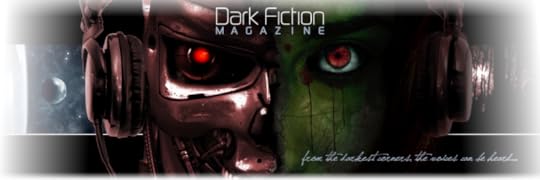
Dark Fiction Magazine, a UK podcast, has posted my story “The Machinery of Government“ as part of Issue 11. The podcast is about 30 minutes long and has a great reading by Danny Davies who brings real sense of terror to the piece. Set in Ottawa, it’s about a newly-minted cabinet minister who must choose between his duty and his wife when Ottawa comes under attack. Thematically, it’s about the dehumanizing aspects of technology.
“The Machinery of Government” first appeared in Tesseracts Fourteen (EDGE Publishing) edited by John Robert Colombo and Brett Alexander Savory.
In other good news, I just received the proofs for Undead Tales 2. In it, I found my zombie story “But It’s Not The End” is the last story in the anthology, which is unknown as the “anchor” story since it’s the last thing the reader will read, anchoring the anthology in the reader’s mind by that story. Undead Tales 2 is edited by Armand Rosamilia and will be published by Rymfire Books.








New podcast and good news for Undead Tales 2

Dark Fiction Magazine, a UK podcast, has posted my story "The Machinery of Government" as part of Issue 11. The podcast is about 30 minutes long and has a great reading by Danny Davies who brings real sense of terror to the piece. Set in Ottawa, it's about a newly-minted cabinet minister who must choose between his duty and his wife when Ottawa comes under attack. Thematically, it's about the dehumanizing aspects of technology.
"The Machinery of Government" first appeared in Tesseracts Fourteen (EDGE Publishing) edited by John Robert Colombo and Brett Alexander Savory.
In other good news, I just received the proofs for Undead Tales 2. In it, I found my zombie story "But It's Not The End" is the last story in the anthology, which is unknown as the "anchor" story since it's the last thing the reader will read, anchoring the anthology in the reader's mind by that story. Undead Tales 2 is edited by Armand Rosamilia and will be published by Rymfire Books.








April 1, 2012
Pre-order Torn Realities Anthology to Get Free Shipping
Torn Realities, an anthology of Lovecraft-inspired stories, is now available for pre-order from Post Mortem Press. It’s $16 (US), but are offering free shipping to the US and Canada if you pre-order now. This is a limited time offer and will not be offered once the book has come back from the printers.
My story “Delta Pi” is included in this anthology as well as those by a number of author writers, including Clive Barker’s “Rawhead Rex.”
Something to note is that this book pays royalties only, so I did not get paid up front for this. But I do get a small slice for every copy sold, so please but a lot!
The cover for it is below.








Pre-order Torn Realities anthology to get free shipping
Torn Realities, an anthology of Lovecraft-inspired stories, is now available for pre-order from Post Mortem Press. It's $16 (US), but are offering free shipping to the US and Canada if you pre-order now. This is a limited time offer and will not be offered once the book has come back from the printers.
My story "Delta Pi" is included in this anthology as well as those by a number of author writers, including Clive Barker's "Rawhead Rex."
Something to note is that this book pays royalties only, so I did not get paid up front for this. But I do get a small slice for every copy sold, so please but a lot!
The cover for it is below.









